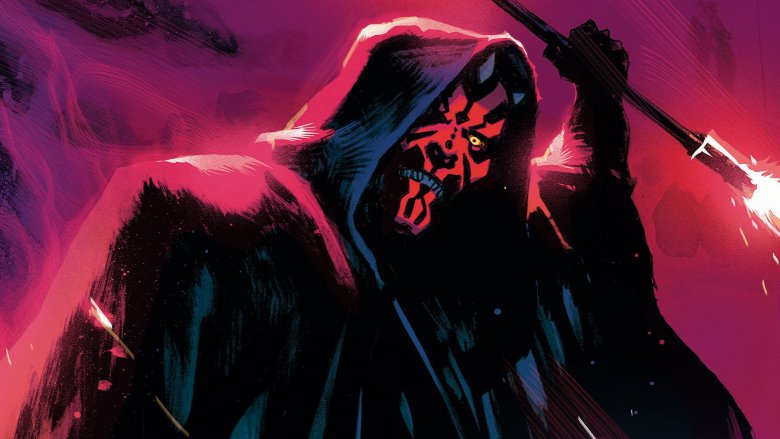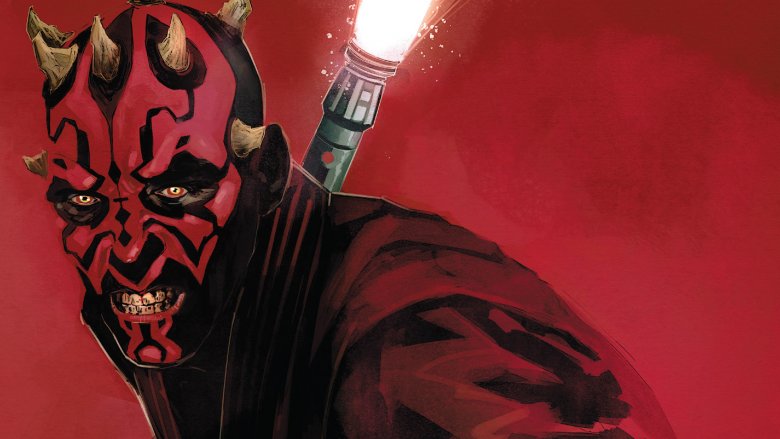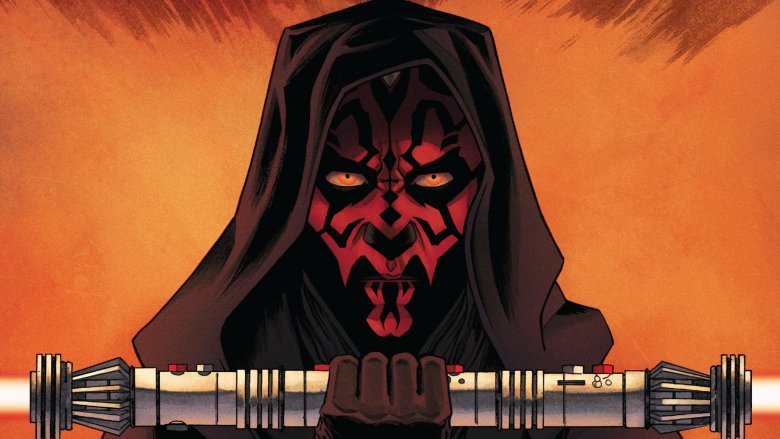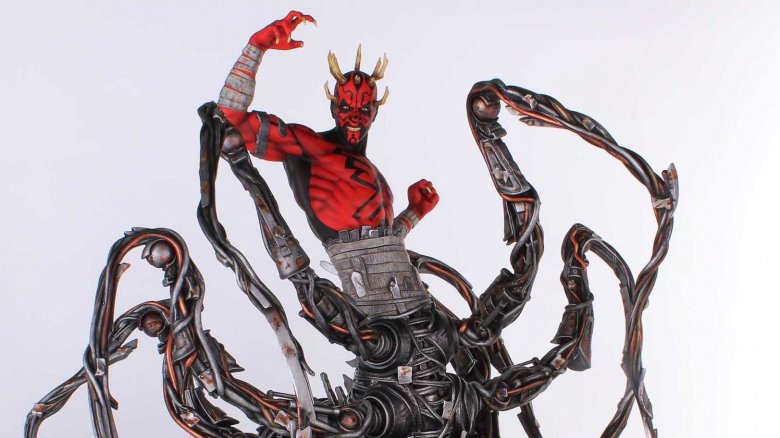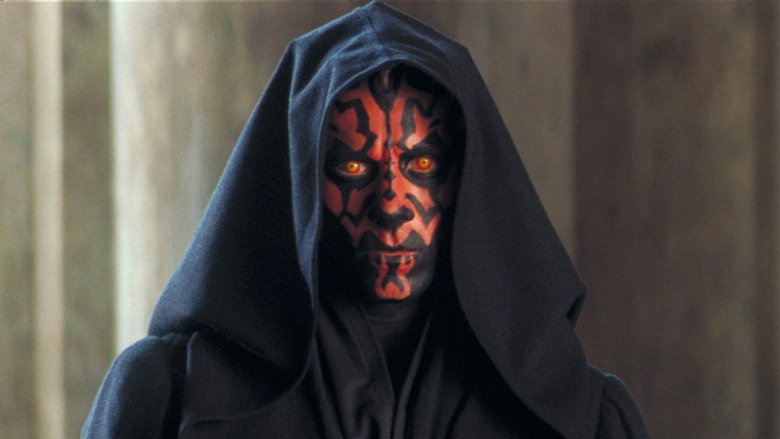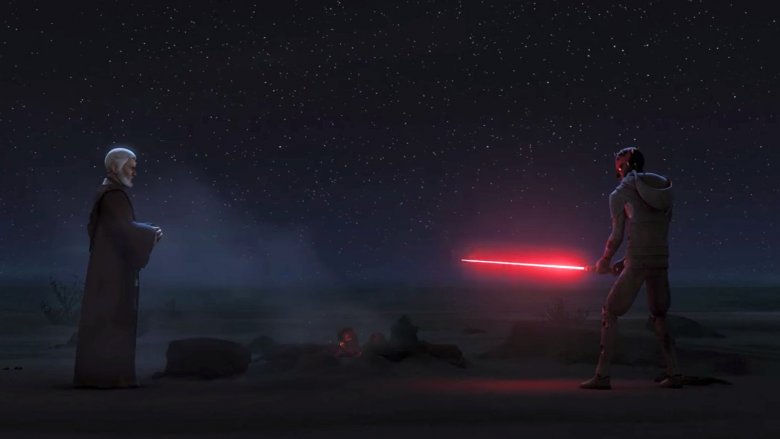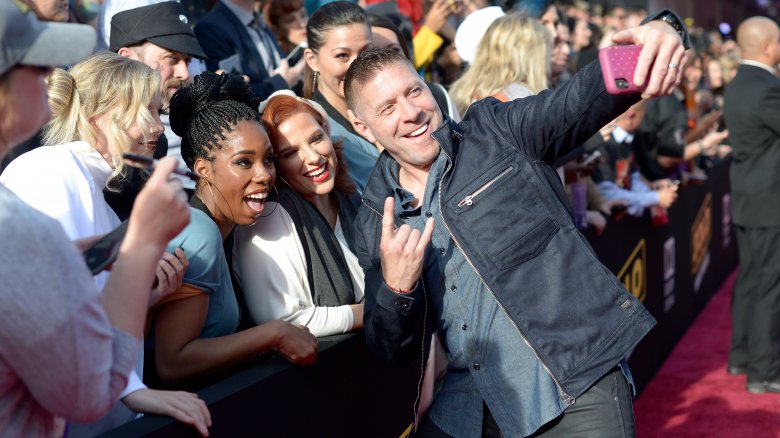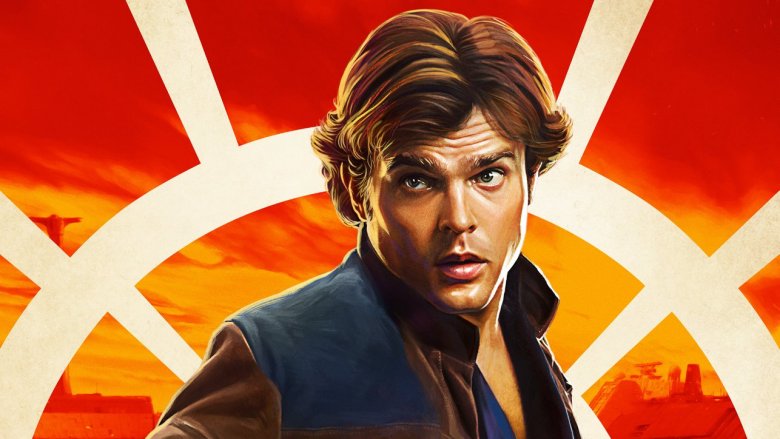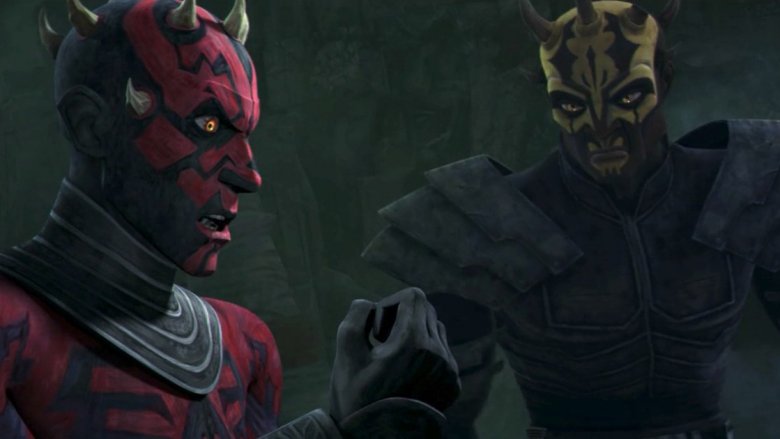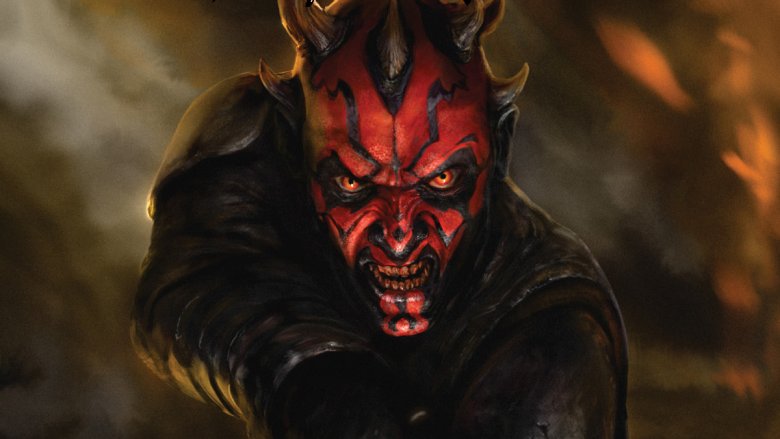What Darth Maul's Appearance In Solo Means For The Future Of Star Wars
Solo: A Star Wars Story was pitched to audiences as a look into the early life and times of Han Solo. But Star Wars fans got a lot more of the history from the world around Han than they might have been expecting. From the roots of the rebellion to the establishment of a network of criminal syndicates, the movie filled out the background world of Star Wars in some surprising ways.
Nothing in Solo was more unexpected than the inclusion of a character long thought to be dead in the mainline movie series: Darth Maul, the Sith lord of few words who made his first appearance in 1999's Star Wars: Episode I — The Phantom Menace. The man we saw get sliced in half by Obi-Wan Kenobi returns in Solo as a menacing crime lord, and his surprise revival suggests a lot of radical changes to come.
While Maul's appearance didn't have much of an effect on Solo's story, it suggests huge implications for the way the Star Wars saga will unfold in its movie series down the line. Let's break down what Darth Maul's appearance in Solo means for the future of Star Wars.
Criminal circle
The most direct plot consequence of Darth Maul's return has everything to do with his new day job: Running a continuing criminal enterprise.
In Solo, Maul is the shadowy leader of the crime syndicate Crimson Dawn, with Dryden Vos and Qi'ra officers near the top of the organization's hierarchy. Before he gets swindled and slain by Han and Qi'ra, Vos mentions that the Crimson Dawn organization is only one of many criminal syndicates.
Other than Crimson Dawn, the galaxy plays host to such groups as the Mandalorian Death Watch, the Hutt Clan, and the Pyke Syndicate, with the Pykes facilitating the smuggling of spice out of Kessel. The other two named organizations have ties to very familiar Star Wars characters — the Mandalorian Boba Fett and Jabba the Hutt, both of whom eventually end up having dealings with Han Solo.
Considering that a Boba Fett movie is in the making and a Jabba appearance is clearly set up by the end of Solo, the intersecting crime syndicates appear to be an ideal way to connect the different Star Wars Stories back into a larger world, with an underground criminal web pulling the sprawl together.
The neverending story
Outside of the plot implications, the Darth Maul cameo in Solo indicates a major shift in how Disney intends to roll out movies in its Star Wars franchise going forward.
Rather than continuing a paradigm of sequential episodes and total standalone features, the series' producers appear to be pivoting to a Marvel Studios-style perpetual motion machine, in which any given movie is always leading you into the next one via foreshadowing, usually in the form of a post-credits teaser.
Post-credits scenes have never been Star Wars' style, but Darth Maul's cameo — and his fleeting appearance is just that — is effectively a post-credits scene buried inside the movie itself. Its only purpose — much like every Marvel stinger dating back to Iron Man and the Avengers Initiative — is to plant a seed in the audience members' minds that there's more story to come, and that it's worth coming back for.
Strike me down...
One of the biggest ways that Solo's Darth Maul scene changes Star Wars as we know it is a subtle thing that, by design, only the biggest fans likely noticed right away.
For decades, both before and after the Disney purchase of Lucasfilm, Star Wars has involved far more than just a series of blockbuster movies. Over the years, all the comics, books, animated shows, and even video games that have come out with the Star Wars brand attached have all been varying degrees of canonical — to some extent, in the Star Wars world, all of those Expanded Universe stories really "happened" (with exceptions for the occasional purge wherein Lucasfilm's story group decides they didn't.)
For fans who only watched the movies, Darth Maul has long been a dead man — no question about it. Obi-Wan Kenobi cut him in half, his eyes bugged out, and then both pieces of him fell what looked like a million feet into the unknown depths of Naboo. But as his appearance in Solo indicates, the movies aren't all that matters anymore.
Back to life
In the canon of the Star Wars Expanded Universe, much of which was jettisoned after Disney purchased Lucasfilm, Darth Maul survived his thrashing at the hands of Obi-Wan Kenobi thanks to the force of the Dark Side and his hatred alone, somehow keeping his guts from falling out as he sulked at the bottom of that big pit on Naboo.
Thoroughly owned by the then-twerpy padawan, Maul ended up being transported to a trash planet, Lotho Minor. There, he passed the time by constructing himself a set of robot spider legs, losing his mind with hatred as he carved out a pitiful, cockroach-esque existence. It makes sense — everyone would probably go a little mad if they had such a frustrating encounter with Ben Kenobi, that notable mangler of limbs.
After his exit from The Phantom Menace, Maul went on to become a pivotal character in the Star Wars: The Clone Wars animated TV series, as well as its follow-up, Star Wars: Rebels. While those shows have been canonical as far as Disney is concerned, their relationship to the movies have typically been a one-way street — until now.
Everything is connected
The biggest implication of Maul's arrival in Disney's revamped Star Wars film franchise is that, as of now, everything in the wider universe of the property now actually matters on a storytelling level.
Fans who neglected the animated series that tracked Maul's rise missed out on all the steps that led to his showing up in Qi'ra's hologram, standing on two robot legs and waving around his infamous double-bladed lightsaber. (He seems to have glued the pieces of his weapon back together since last time we saw him; if you'll remember, Obi-Wan sliced that in half, too.)
The fact that Maul's story is now being folded back into the movies after a long time spent developing it on the small screen has huge implications for the rest of the Star Wars canon. Suddenly, all the characters from Disney's new Expanded Universe that have never before appeared in a movie feel like fair game to get called up to the movies' major leagues — and that's never really felt like a possibility before.
Versus Obi-Wan
One interesting thing about Maul's appearance in Solo is the fact that his story won't necessarily be explored in a Solo sequel. After all, Han Solo and Darth Maul aren't known for their dealings together. They may as well be ships passing in the night, Han a lowly minnow floating around Darth Maul's criminal ocean.
Maul's real nemesis, of course, is the man who nearly killed him in the first place — Obi-Wan Kenobi.
Maul's quest for vengeance against the self-exiled Jedi dominated his story in Star Wars: Rebels, which canonically takes place several years after the events of Solo: A Star Wars Story. (The bulk of Solo takes place in the year 10 BBY, 10 years before the events of A New Hope, while Star Wars: Rebels takes place between 5 and 1 BBY.)
That quest for revenge comes to fruition in the Star Wars: Rebels episode "Twin Suns," with Maul finally tracking down Obi-Wan while he's in hermetic isolation on Tatooine. Their duel doesn't end well for Maul, with Obi-Wan dispatching him almost effortlessly. As it turns out, Maul's story ends just like we thought it did in 1999 — terminated with embarrassing proficiency by Obi-Wan.
But even though we know where Maul's story ends up, there's still a lot of story left to tell, with years' worth of gaps to fill in the wider narrative. With Obi-Wan all but confirmed to be getting a solo movie of his own, the question is obvious. Could Maul's story continue in that film?
Rumor has it
The actor who portrayed Darth Maul in Solo is the same one who first brought him to life in The Phantom Menace: martial artist Ray Park. Since Maul appeared in Solo, the rumor mill has been churning out potential places the character could go next.
As of now, we know that we can expect a series of movies from the creators of Game of Thrones, a trilogy from The Last Jedi director Rian Johnson, J.J. Abrams' Episode IX, a Boba Fett movie with James Mangold directing, and finally, the unannounced Obi-Wan-centric spinoff.
While the Obi-Wan project is the only one in the list that hasn't been confirmed by Disney, the rumor as of this writing is that his movie's coming next — and Park's Maul may indeed be involved.
Reports indicate that the Obi-Wan movie is currently in pre-production, scheduled to be filmed after Episode IX wraps. According to the often-reliable rumormongers at That Hashtag Show, Park himself heavily implied after Solo's release that the Obi-Wan movie is next on deck for Disney — and would he really be privy to that info if he wasn't involved in some way?
It's all subject to change, but it feels compelling. Crime lord or not, Maul doesn't really belong in a Solo sequel — not as much as Jabba and his people, or the bounty hunter Boba Fett. But an Obi-Wan movie is a perfect fit, and may be where we can expect Maul's story to properly pick up next.
Solo solitario
Another knock against Maul ever appearing in a Solo sequel is the increasingly likely scenario that the smuggler-centric Star Wars Story isn't going to get one.
Whether or not Solo was a box office bomb depends on your definition of the term, but by anybody's metric, it was certainly a disappointment, taking in just over $103 million during its long first weekend. For any other movie, that's a coup, but for Star Wars — especially this Star Wars, with its expensive reshoots and typically massive marketing budget — it amounts to an all-time low, unless you count the theatrical release of the animated Star Wars: The Clone Wars.
What should especially sting to Disney and Lucasfilm is that, a month before the movie's release, analysts felt confident predicting an opening in the neighborhood of $170 million — a number that kept shrinking as the release date neared, until the bottom ultimately fell out during release.
While star Alden Ehrenreich is contracted for three movies, it doesn't necessarily mean they're going to happen — and with audience enthusiasm for Solo being relatively muted, it's not a stretch to imagine that Disney will write it off as more of a learning experience than a story to build on directly with sequels. In other words, if you want to see the continuing story of Darth Maul, it might be wise to look elsewhere.
Magical new worlds
At the conclusion of Solo, Maul summons the duplicitous Qi'ra to come and meet with him on his home planet of Dathomir, a world previously unseen in any Star Wars sequel. In the Expanded Universe, whole comic series have focused on the strange magic and intense warrior societies that exist on the blood-red planet, previously visited in Star Wars: The Clone Wars.
Dathomir has played host to a number of malevolent Force users — not Jedi, not Sith, but something in between. Along with his brother Savage Opress, Maul was raised on the planet by a society called the Nightsisters — Force-sensitive witches who used Dathomir's strange energies to wield potent magic.
The existence of wizardry on the fringes of the Force is an aspect of Star Wars that's remained relatively unexplored in the movies. In the film series, any mystic character has typically been either a Jedi or a Sith, but in the Expanded Universe, the Force is more like a spectrum. For one thing, there's the existence of Gray Jedi who draw from both the light and dark sides of the Force. Additionally, the Force-sensitive Chirrut in Rogue One: A Star Wars Story also broadened our understanding of how the Force manifests.
Maul's story could further that developing understanding in the movies. His home world would be a perfect venue for expanding Star Wars' presentation of the mystical, adding some mystery back to the Force by demonstrating that it's not always as simple as a light side and a dark.
Expanding universe
Another aspect of the continuing Marvel-ization of the Star Wars franchise involves looking to the Expanded Universe — both the old, pre-Disney canon and the new one — for story inspiration. Until now, the non-movie stories have effectively functioned as relatively inessential tales that pass the time between films, maintaining the tone of the universe while introducing fun side characters and following their adventures.
With Solo, the Star Wars franchise made its biggest pulls from Expanded Universe material yet. It had happened before — the name of Chewbacca's home planet, Kashyyyk, was originally introduced in the Star Wars Holiday Special before being called up to the big leagues in Star Wars: Episode III — Revenge of the Sith. But Solo deputizes the Expanded Universe to an extent the movies simply haven't done before, taking much of Han Solo's backstory — established in comic books and novels for years in between the release of Return of the Jedi and The Phantom Menace — and sealing it into the world of the movies.
Until Solo, the Expanded Universe developments all reacted to the gospel events of the movies, but now, it works both ways. The Expanded Universe matters. The implications are that Expanded Universe plots, settings, and even beloved characters like Ahsoka Tano and the morally flexible badass Mara Jade could potentially make debuts in the movies.
There's nothing more Marvel-esque than basing movies off of comic books. Is that the future of Star Wars now? As Darth Maul's presence in Solo demonstrates, anything is possible.
